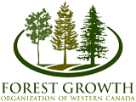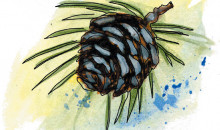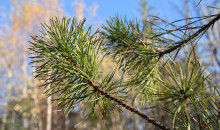Quick Links
January 21: Monitoring Operations with Satelites
March 18: Fertilization to mitigate climate change – experiences from fertilization trials in Sweden
March 25: Pining for home: seed source selection for future forests
Playlist of all FGrOW webinars
January 21: Monitoring operations with satellites
Gordon Whitmore
Abstract
Supervision of operations in the boreal forests of Alberta is a challenging and often dangerous task, requiring extensive travel to remote sites over low quality access while being subject to winter cold, storms and driving in the dark. It’s not uncommon for supervisors to spend 6-8 hours travel time to check in on our contractors at the various stages of their operations, or to assess the same sites for activities following operations such as pile burning, gps’ing of roads, crossing removals, roll back of roads, etc. While in-person inspections will always be a necessity, the use of remote sensing to monitor operations may provide a tool to reduce the number of visits our personnel must make and significantly reduce what has been identified as our highest safety risk for Woodlands staff. With this in mind, Mercer initiated a trial of Planet’s SkySat constellation that allows Mercer to task the satellites to take weekly high resolution imagery of it’s winter operations. While the trial was initiated in November 2021 and is still on-going, early results suggest that it will allow for the reduction of site visits, a tool for near-real time assessment of compliance with plans and application for spatial identification of roads, landings, debris piles, retention and possibly cut-block updates.
Presenter Bio
Gordon Whitmore is a Registered Professional Forester employed with Mercer Peace River Pulp Ltd. as the Land Management Superintendent. Following completion of a bachelor’s and a master’s in forest science at Lakehead University, he has worked in the forest industry over the past 28 years in all aspects of the forestry profession. Gord currently leads a team of specialists in the research, development and evaluation of strategic initiatives and innovations focused on delivering solutions for sustainable forest management. Key areas of focus include integrated land management, advanced silviculture practices, ecosystem-based management, applications of remote sensing, species at risk, carbon offsets, ecosystem services and methods for meeting the challenges of climate change.
February 18: Pre-commercial and Commercial thinning in the Northeast USA: A summary of seven years of research
Anil Kizha and Libin Louis
Abstract
Developing and implementing thinning prescriptions are considerably more challenging than clearcut harvesting. Factors influencing the effectiveness and efficiency of thinning operations/outcomes include the: silviculture prescription, species harvested, stand composition, market factors, desired residual stand conditions, and the selection and combination of harvest equipment. This presentation summarizes seven years of applied research in thinning, conducted across ten timber harvesting operations in the Northeast United States. The types of thinning operations that were studied include: pre-commercial thinning (PCT), early commercial thinning (ECT) and commercial thinning (CT). Residual stand condition and damage was quantified in relation to the various harvesting methods and the cost and effectiveness of Best Management Practices (BMPs) designed to reduce the impact of harvest equipment on forest soils will also be discussed. Harvest productivity and costs will be compared by harvesting method across contrasting silvicultural prescriptions. Finally, a global meta-analysis of the factors affecting harvest productivity and costs for ground-based equipment will be presented. The majority of these studies were conducted on long-term research plots, which provides the additional opportunity to track impacts over the full rotation.
Presenter Bios
Dr. Anil Raj Kizha is an Associate Professor of Forest Operations and Forestry Program Leader at the School of Forest Resources, University of Maine, Orono, ME. Dr. Kizha’s research is focused on forest operations and management including factors influencing timber harvesting operational costs while reducing the impact on residual stand quality and productivity, soils and water quality. Dr. Kizha also serves as an adjunct professor at Humboldt State University, Arcata, California and is an associate editor for the Forest Chronicle.
Libin T. Louis is an Assistant Professor in Forestry at the University of Maine, Fort Kent, ME. Libin completed a master’s of science in forestry from the University of British Columbia and a PhD in Forestry from the University of Maine, Orono, ME. Libin’s research interests include the production economics of harvesting, small diameter tree harvesting, effects of silvicultural prescriptions on harvesting, and residual stand damage. His doctoral research focused on evaluating the operational feasibility of harvesting small-diameter trees and exploring the constraints in harvest decision making. An outcome of his research is a novel technique to estimate the costs of harvesting small-diameter trees. Libin currently teaches undergraduate forestry related courses at UMaine Fort Kent, including Forest Ecology, Forest Mensuration, and Timber Harvesting, and Forest Products and Transportation. Libin has been awarded the Queen Elizabeth II Diamond Jubilee Scholarship, from the University of British Columbia for Green Leaders, and the Ralph H. Griffin Memorial Scholarship from the University of Maine as a meritorious graduate student in the the fields of silviculture, forest management or forest soils.
March 4: Pre-commercial and Commercial Thinning in Sweden: what has been learned that could be applied in Alberta?
Urban Nilsson
Abstract
Sweden has a long history of research and practice in pre-commercial thinning (PCT) and commercial thinning (CT). This talk will cover lessons learned from density management studies on Scots pine and Lodgepole pine which is an exotic commercial tree species in Sweden. Results from various PCT, CT and fertilization trials in Scots pine and lodgepole pine established during the 1960s to the 2010s will be presented.
Presenter Bios
Urban is currently the silvicultural program leader in the research program “Trees for the Future (T4F)” and “Trees For Me (TFM)”. His involvement in the programs includes research on mixed species stands, comparison of production and biodiversity in Scots pine and Norway spruce, fast growing deciduous species, models of site productivity and continuous cover forestry. His research program has focused on the production and economy of Sweden’s three major native tree species, Norway spruce, Scots pine, and Silver birch, and includes introduced tree species such as lodgepole pine, hybrid larch and Douglas fir.
March 18: Fertilization to mitigate climate change: experiences from fertilization trials in Sweden
Johan “Kotte” Bergh
Abstract
Fertilization is one way to increase forest productivity and has been used as a silvicultural tool in Sweden since 1960. Traditionally, operational application of fertilizer in Norway spruce and Scots pine has been in the second half of the rotation. Nitrogen (N) is the primary limiting nutrient and a nominal application rate has been 150 kg N per hectare. However, there is consideration for introducing a more intensive fertilization programme in young stands given that fields trials in Norway spruce has demonstrated large increases in stem-wood production (100-300%). Increased growth implies a higher rate of carbon sequestration and carbon storage per unit of time and could be considered as an effective method for climate change mitigation. Another outcome is more wood that can be utilized for product substitution to replace fossil fuels, concrete- and metal construction materials.
Presenter Bio
Dr. Johan “Kotte” Bergh is a Professor of Silviculture in the Department of Forestry and Wood Technology at Linnaeus University in Växjö, Sweden. His research program is focused on understanding how nutrient dynamics and climate change could affect boreal forest ecosystems, including risks related to climate change. Adaptive forest management is one mitigation method to limit potential risks and minimize damages from a changing climate. Collaboration with the Swedish forest industry and society constitutes a majority of Kotte’s work.
March 25: Pining for home: seed source selection for future forests
Greg O’Neill
Abstract
The intention of this presentation is to deconstruct the 100-year-old paradigm of reforesting with local seed sources and discuss the construction of a 21st century seedlot selection system. Abundant evidence already links large-scale forest disturbance with 20th and 21st century climate change. As the rate of Anthropocenic climate change continues to outpace the ability of natural systems to respond through natural selection and migration, tree populations are becoming increasingly distanced from their climatic optimum, maladapted and susceptible to pests and disease. In forested ecosystems, where trees are often foundation species, the stability of ecosystems and the diversity of life that they support are jeopardized.
Assisted migration – reforesting with tree seed sources from climates that are slightly warmer than the planting site – can help mitigate forest maladaptation associated with evolutionary lag due to Anthropocenic climate change and climate change expected during the life of the planted forest. This presentation will discuss a) the rationale for an improved seedlot selection system; b) options for seedlot selection systems; and c) implementation and operational challenges and benefits of the new system in BC.
Presenter Bio
The focus of Greg O’Neill’s research is on understanding the nature and distribution of adaptive variation of BC’s tree species and applying this understanding to reforestation practices to help ensure BC’s forest plantations remain healthy and productive in new climates. Greg is a professional forester with degrees in biology, forest ecology and forest genetics. He has worked in environmental consulting, international development, seedling production, and for the last 20 years, in the Forest Genetics section of the Forest Improvement and Research Management Branch of the BC government.










